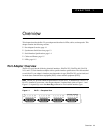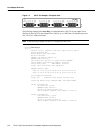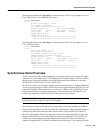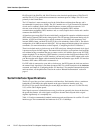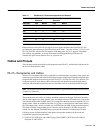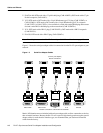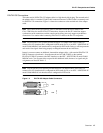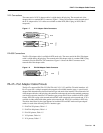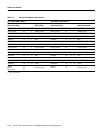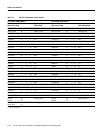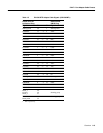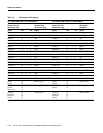
Overview 1-3
Synchronous Serial Overview
The following example of the show diag slot command shows a PA-4T+ in port adapter slot 1 in a
Cisco 7200 series or a cisco uBR7200 series router:
Router# show diag 1
Slot 1:
Mx serial port adapter, 4 ports
Port adapter is analyzed
Port adapter insertion time 02:19:52 ago
Hardware revision 1.0 Board revision UNKNOWN
Serial number 3701161 Part number 73-1577-03
Test history 0x0 RMA number 00-00-00
EEPROM format version 1
EEPROM contents (hex):
0x20: 01 0C 01 00 00 38 79 A9 49 06 29 03 00 00 00 00
0x30: 05 00 00 00 FF FF FF 00 FF FF FF FF FF FF FF FF
The following example of the show diag slot command shows a PA-4T in port adapter slot 1 in a
Cisco 7100 series router:
Router# show diag 1
Slot 3:
Serial port adapter, 4 ports
Port adapter is analyzed
Port adapter insertion time 02:19:52 ago
EEPROM contents at hardware discovery:
Hardware revision 1.0 Board revision A0
Serial number 37296561 Part number 73-1556-04
Test history 0x0 RMA number 00-00-00
EEPROM format version 1
EEPROM contents (hex):
0x20: 01 11 01 00 00 A4 19 EC 49 06 98 04 00 00 00 00
0x30: 50 00 00 00 98 10 21 00 FF FF FF FF FF FF FF FF
Synchronous Serial Overview
The PA-4T+ provides four channel-independent, synchronous serial ports that support full-duplex
operation at T1 (1.544-Mbps) and E1 (2.048-Mbps) speeds. Each port supports any of the available
interface types: Electronics Industries Association/Telecommunications Industries Association
(EIA/TIA)-232, EIA/TIA-449, V.35, X.21, and EIA-530.
EIA/TIA-232, which is by far the most common interface standard in the U.S., supports unbalanced
circuits at signal speeds up to 64 kbps. EIA/TIA-449, which supports balanced (EIA/TIA-422) and
unbalanced (EIA/TIA-423) transmissions, is a faster (up to 2 Mbps) version of EIA/TIA-232 that
provides more functions and supports transmissions over greater distances. The EIA/TIA-449
standard was intended to replace EIA/TIA-232, but it was not widely adopted.
Note The EIA/TIA standards were referred to as recommended standards called RS-232 and
RS-449 prior to their acceptance by the ANSI committee.
The resistance to convert to EIA/TIA-449 was due primarily to the large installed base of DB-25
hardware and to the larger size of the 37-pin EIA/TIA-449 connectors, which limited the number of
connections possible (fewer than is possible with the smaller, 25-pin EIA/TIA-232 connector).
EIA-530, which supports balanced transmission, provides the increased functionality, speed, and
distance of EIA/TIA-449 on the smaller, DB-25 connector used for EIA/TIA-232. The EIA-530
standard was created to support the more sophisticated circuitry of EIA/TIA-449 on the large
number of existing EIA/TIA-232 (DB-25)hardware instead of thelarger, 37-pin connectorsused for





